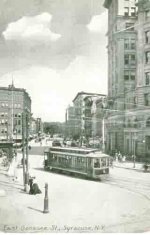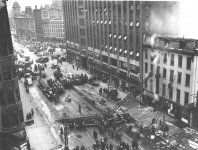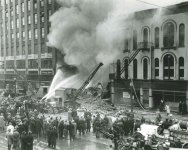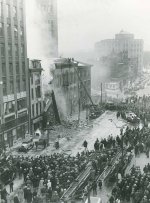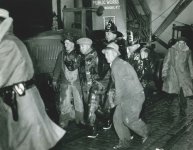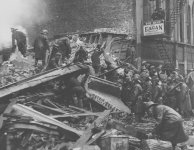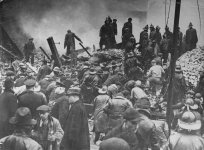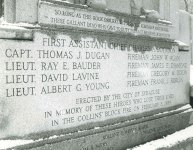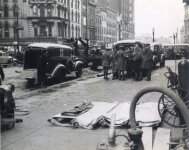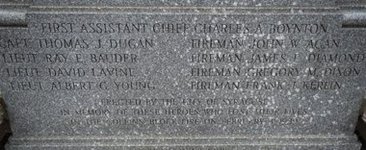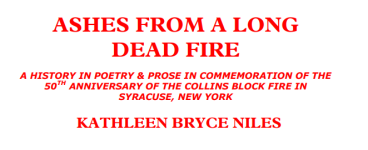SFD Line of Duty Deaths
February 3, 1939 - Syracuse, NY Office Building Fire. 9 Firemen plunged to their deaths.
Nine firemen, trapped in the collapse of a burning office building, were given up for dead today as rescue crews searched the still smoking ruins in the heart of the city's business section. "All hope has been abandoned," declared the Fire Chief Edward W. Gieselman "The men are dead -- they are buried under tons of wreckage." Hours after the collapse of the final wall, occasional spurts of flame still came from the blackened ruins hindering the work of weary rescue crews who continued their hopeless effort to reach the entombed men. Gieselman, said it might be hours before the bodies of the firemen were removed. Meantime in a fire station less than a block away, weeping wives and children of the missing men huddled together still awaiting a word of hope. District Attorney Donald MacWhinney already had launched an investigation into the cause of the fire. He said one of the first witnesses questioned was Clifford Keep, operator of a restaurant on the ground floor of the wrecked building, which was known as the Collins block. Mr. Keep had experienced some labor trouble recently, MacWhinney said and that he intended to investigate the situation.
Syracuse (AP) -- Rescue crews searched the smoking ruins of a five-story brick office building at dawn today for nine firemen trapped when the roof of the fire-swept structure collapsed. Amid uncertainty whether any of the six remained alive, the city mobilized its police, fire and public works department forces to speed the work of rescue. A seventh fireman, rescued an hour after the collapse, was taken to a hospital critically injured. Fire department officials reported the missing men were on the third floor of the building, when the roof collapsed with a roar like an explosion, carrying them into the cellar under a mass of falling wreckage. Rescue efforts were hindered by fear that the work of digging in the ruins might bring down one of the walls of the ruined building. All ambulances in the city were dispatched to the scene. The rescued man, removed from the wreckage through a sidewalk grating, was identified as Fireman William F. Moore. Those still missing were listed as: Lieutenant David Lavine. Lieutenant Albert G. Young. Lieutenant Raymond E. Bauder. Fireman John W. Agan. Fireman James E. Diamond. Fireman G. Michael Dixon. Fireman Frank Kerlin
District Chief Thomas J. Dugan was also reported missing. It was not immediately known whether or not he was buried in the debris with the other missing men. Police and fire department officials said the cause of the blaze which was discovered at 1:50 A.M., was uncertain. Scores of fire companies, called out by a general alarm, poured streams of water into the building for 45 minutes before the flames were brought under control. Collapse of the roof occurred at about 4 A.M. as firemen poked through the smoke-filled upper floors. The wrecked building is located on East Genesee Street, near the heart of the business district and a block off Salina Street, main thoroughfare of the city. The first floor was occupied by a restaurant, while the upper floors were untenanted. Officials of the Onondaga County Savings Bank, which owns the structure, were unable to estimate the loss immediately. The operator of the ground floor restaurant, however, estimated her own loss at $7,000 to $10,000. Despite the early hour at which the fire occurred, hundreds were attracted to the scene by the spectacular blaze. For a time, adjoining structures were threatened by a westerly wind which showered them with sparks. Fire Marshall Charles Wilkes said firewalls apparently saved buildings immediately adjoining.
The Daily Messenger Canandaigua New York 1939-02-04
In the end the dead were:
Asst Chief Charles A Boynton
District Chief Thomas J. Dugan
Lieutenant David Lavine Engine 6
Lieutenant Albert G. Young Engine 2
Lieutenant Raymond E. Bauder Engine 3
Fireman John W. Agan Engine 1
Fireman James E. Diamond Engine 1
Fireman G. Michael Dixon Engine 3
Fireman Frank Kerlin Truck 6
Fireman William F. Moore
